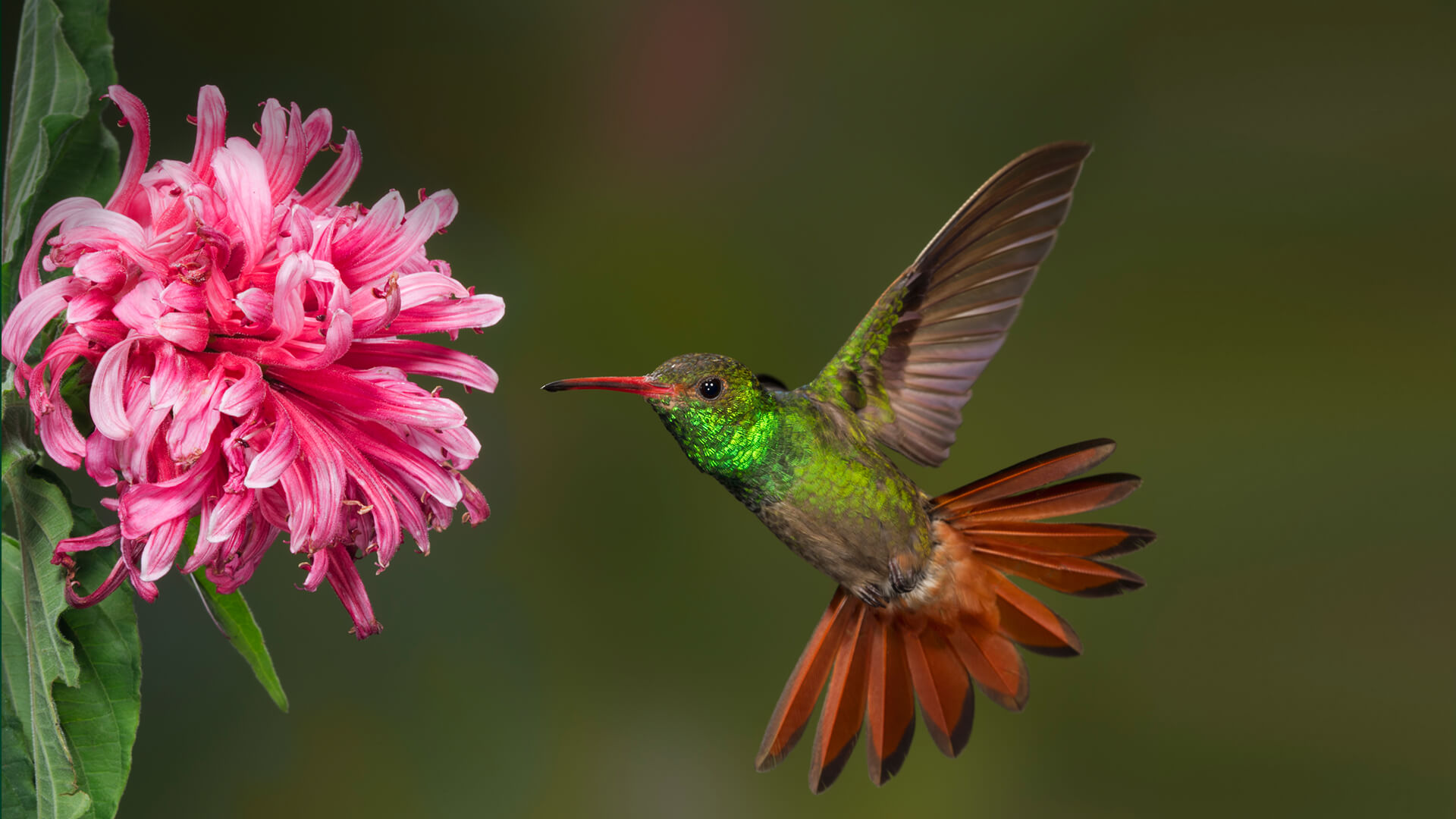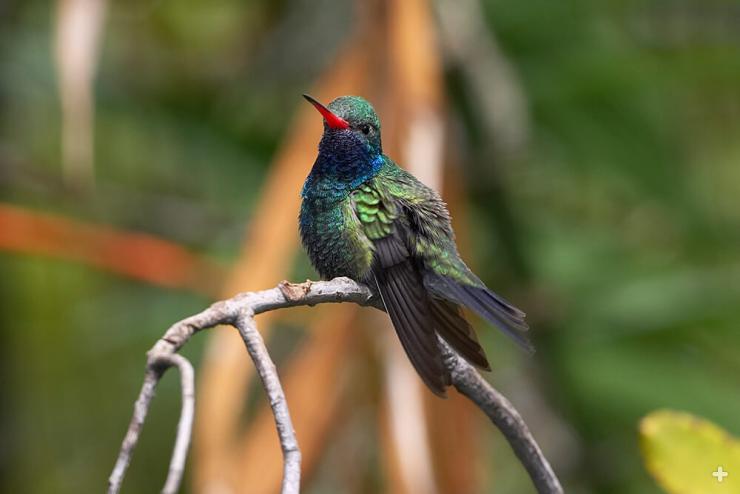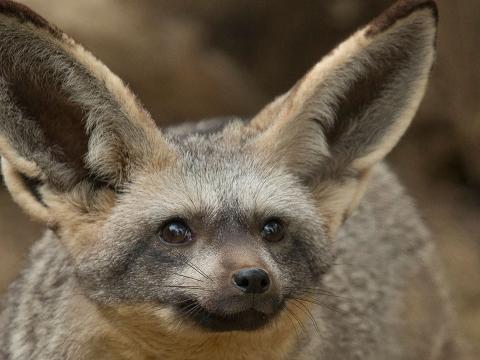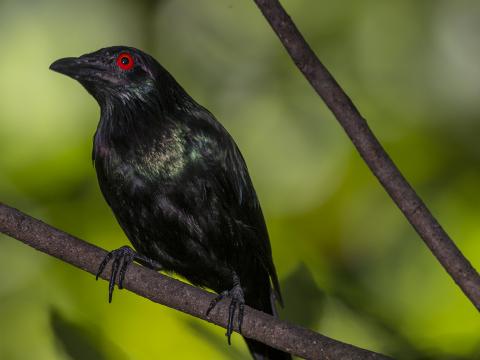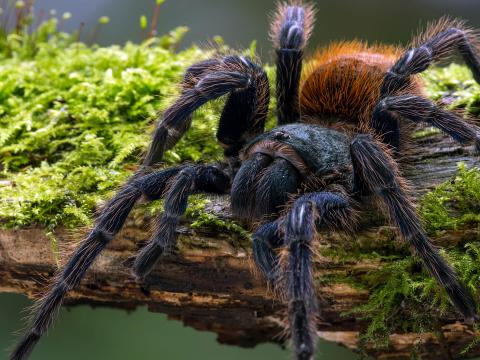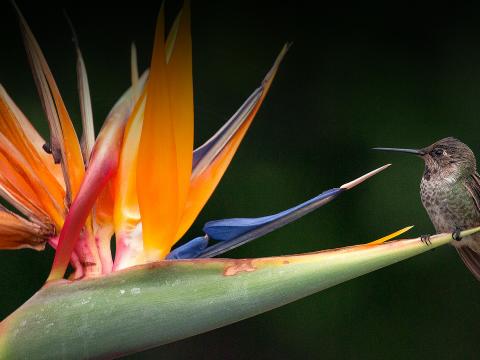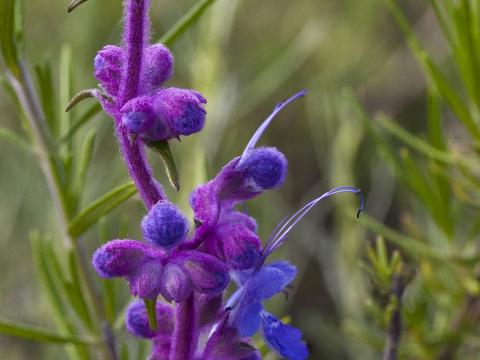Hummingbird
- CLASS: Aves (Birds)
- ORDER: Apodiformes
- FAMILY: Trochilidae
- SUBFAMILIES: Phaethornithinae (hermit hummingbirds) and Trochilinae (typical hummingbirds)
- GENERA: 102
- SPECIES: 328 known
ABOUT
Little birds with big appeal: Hummingbirds include the smallest birds in the world, but they belong to one of the largest group of birds, the Trochilidae family. These enchanting birds are found in deserts, mountains, and plains, but most live in tropical rainforests. Their name refers to the humming sound made by their tiny, beating wings; each species creates a different humming sound, depending on the speed of its wing beats. In the Caribbean, people call the hummingbird el zunzun. These energetic dynamos have been around for ages; hummingbird fossils found in Germany are said to be more than 30 million years old.
There are 328 hummingbird species. The smallest is the bee hummingbird from Cuba, and the largest is the giant hummingbird from South America. Hummingbird bills come in different sizes and shapes, too. The long, slender bill is adapted to collect nectar from flowers. The bill protects the long, split tongue and allows each kind of hummingbird to feed from specific types of flowers. Hummingbirds are called nectivores, because about 90 percent of their diet is the nectar from flowers. They also snack on insects, which they often catch by “hawking.” A hummingbird “hawks” insects by flying and diving to snap them up out of the air.
Hummingbirds come in all colors of the rainbow, and some of their feathers actually change color as they move in the light. Common names such as green-crowned comet, sapphire-vented puffleg, and ruby-throated describe the beautiful, fancy feathers of hummers. Most hummingbirds are colored in shades of blue and green, with the male being much brighter than the female; after all, she has to blend in to her nest while incubating her eggs. In the mid-1800s, hundreds of thousands of hummingbirds were killed for their feathers, and some almost became extinct. Luckily, people today realize that the feathers look much better on the birds!
If a hummingbird sees a hawk or other bird that it doesn’t want in its territory, it gives a high-pitched warning and starts doing dive attacks. Other hummers and even other kinds of birds often join in to dive-bomb the intruder until it leaves. The hummingbird is fearless, as it can outmaneuver everything unless taken by surprise.
When it comes to flying, nobody does it better. Like a helicopter, a hummingbird can go up, down, sideways, backward, and even upside down! Most of its wings are made of hand bones instead of arm bones like other birds’ wings. When hovering, the wings turn in opposite directions and then reverse themselves in a figure-eight movement. Hummingbirds also have muscles that power both the up and down stroke instead of just the down stroke, as in other birds. They can beat their wings from 20 to 200 times per second. Hummingbirds are such good fliers that most of them never walk.
As tough as they are, hummingbirds still face a few clever predators. Hummers have been caught by dragonflies, trapped in spiderwebs, snatched by frogs, and stuck on thistles. Perhaps the most surprising predator is the preying mantis. The insect sits motionless and camouflaged on a leaf or twig and strikes with furious speed and power to nab a small hummer. Other birds, such as orioles and roadrunners, occasionally eat hummingbirds.
Thousands of plants native to the Americas rely on hummingbirds for pollination. Hummers like flowers that are bright and are open during the day, when the birds are awake. They get most of their nectar from tubular blossoms, the perfect shape to accommodate their long, slim beak and tongue. Some have a bill perfectly adapted to very specific nectar-bearing flowers; for example, the bill of a buff-tailed sicklebill matches the curve of Heliconia flowers. Since they don’t have a strong sense of smell, hummingbirds are not attracted by fragrance, but it’s easy for them to see red, so they’re often drawn to red flowers, which many nectar-loving insects can’t see. Hummers can hover up to downward-hanging blossoms where bees and other insects can’t find a landing spot.
And how do hummers help the plants? As the birds use their bill to get at a flower’s nectar, pollen from the flower dusts their head. Whey they zip to the next blossom, they deposit the pollen to help the flower reproduce. Hummingbirds are rainforest gardeners!
You might think a hummer’s day is spent flying from flower to flower in search of nectar, but a hummingbird also bathes several times a day, splashing in shallow water or sitting near a waterfall or a sprinkler and letting the spray fall on them. Some take advantage of the rain by perching on a branch and spreading their wings and tail. A few even dive in and out of water and then shake their feathers. After each bath, the hummer spends its time arranging, oiling, and cleaning its feathers with its bill and claws.
In general, wildlife do not make good pets—and hummingbirds are wildlife. Hummingbirds have a specialized diet that is difficult to duplicate, so they would be hard to feed properly, and they might get sick and die too soon. They prefer to live in a large territory, where they can use their specialized flying skills to find food and mates, which would be difficult to provide for a pet. They are also territorial and very assertive, bold little birds, and it is unlikely they could be the affectionate companions that people expect of their pets. It is best to enjoy them as they are.
HABITAT AND DIET
Hummingbirds live in a surprising variety of habitats. Some live in the high altitudes of the Andes Mountains, where they encounter frost and snowfall. When it’s especially cold, these hummers seek shelter in caves. Other species are found in cool and dry grasslands, forest lowlands, tropical rainforests, and even desert areas. Many hummingbirds routinely migrate 500 miles (800 kilometers) or more every year. The rufous hummingbird migrates a whopping 3,000 miles (4,800 kilometers) from Mexico to Alaska, where it breeds during the summer.
Even though hummingbirds are small in size, they have a large appetite. Their diet is mostly liquid—nectar—and these birds get plenty of exercise with all that zipping around just to get from sip to sip. These petite birds consume between 3.14 and 7.6 calories a day. That may not seem like much, but if humans (who may eat 3,500 calories a day) had the metabolism of a hummingbird, they would have to consume approximately 155,000 calories a day. That’s about 77 times as much as most humans eat! The hummingbird’s need for lots of calories is due to its high heart rate and small body size. Some hummers have been observed visiting 20 flowers a minute, and with their hover-and-sip style of feeding, they keep beating their wings and working out even while they eat.
Because they eat so much, hummers must digest their food quickly. They can digest a fruit fly, soft insect, or spider in 10 minutes. To get through the night without making dozens of food runs, hummingbirds go into a kind of nocturnal hibernation, lowering their body temperature and heart rate so they can get some rest.
At the San Diego Zoo, hummingbirds eat specialized nectar that provides a complete nutritional diet, plus fruit flies for added protein.
FAMILY LIFE

Male hummers use their brilliant colors to court females. It is thought that the shinier a male’s feathers are, the healthier he is. If defending a territory, the male tries to stand out as much as possible by flashing his iridescent feathers, which are on the throat, head, tail, or back. Hummingbird eyes are sensitive to ultraviolet light, so colors may appear even more vibrant to them than to human eyes.
These color signals only work at close range, so hummers also vocalize with high-pitched short chirps and whistles. Some have an elaborate musical whistle to attract a female’s attention. Males defending territory make what are called “chase calls,” which are rapid chatters unique to each species. If the offending male doesn’t leave, the two may fight, grasping each other in flight and tumbling to the ground.
Hummingbirds are not very social, which is why you never see them flying in flocks. In fact, males and females live apart until breeding season, when a male calls to a female and shows her his beautiful feathers. Some male hummingbirds attract a female by forming a lek, which can include up to 100 males. If a female seems interested in one of the males, he may perform a flying dance for her in the air.
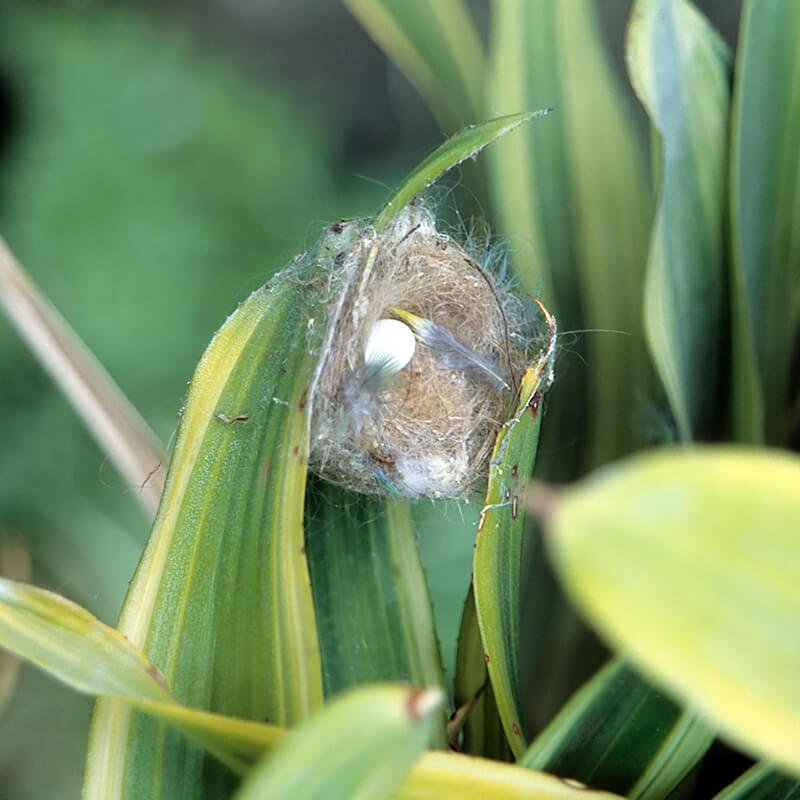
Once they mate, the female must build her nest and raise her young on her own. Her nest is made of a variety of materials that may include moss, leaves, hairs, feathers, and wool. It is held together and attached to branches using spider webs. The eggs of the smaller hummingbirds are the size of a coffee bean. Hummingbird chicks hatch with their eyes sealed shut. They have only a little down on their body and just a bump for a bill. These tiny chicks are very vulnerable, and sometimes their predators include large insects! Fortunately, their mothers are very protective. The young birds fledge in three to four weeks, and sometimes a mother goes on to raise a second brood.
AT THE ZOO
The William E. Cole Family Hummingbird Habitat opened at the Zoo in June 2021. It is an immersive, walk-through experience that offers endless flight opportunities to several species of hummingbirds, as well as other distinctive birds and plants native to North and South America. The habitat includes novel educational opportunities for guests to connect with these tiny, colorful-feathered and important pollinators, heightening San Diego Zoo Wildlife Alliance’s ability to convey the plight of each species and share information about what steps people can take to help conserve wildlife in their own backyards. The Hummingbird Habitat features cascading water, orchids, anthuriums, palms and other rare plants reflecting the diversity and beauty of the birds’ native regions—as well as an open-water pool that guests can view from an observation bridge along the pathway.
Did you know that San Diego County is home to three hummingbird species? They are Anna’s, Allen’s, and Costa’s hummingbirds. The Allen's type can be confusing as there is a migratory subspecies (sasin) that passes through the region, and we have a resident subspecies (sedentarius). Anna’s hummingbird is the one commonly seen in our gardens all year. Summer is a good time to look for hummingbirds. Listen for the telltale buzz, and look up—as fast as you can! Are your eyes sharp enough to follow a hyperactive hummer to its next nectar stop?
CONSERVATION
The metallic or iridescent color of hummingbird feathers and minute size of the bird itself made the hummingbird a target for collectors in the 19th century; wealthy people often displayed a case of stuffed hummingbirds in their home. Fortunately, most hummingbirds have adapted to the presence of humans. It is important to keep native plants in hummingbird habitat so the birds still have food available. Gardens that include hummingbird-friendly flowers have helped strike a balance with humans in hummingbird habitat. However, in many parts of the world the human population is growing so fast that hummingbirds are losing their habitat.
To help hummingbirds in your own neighborhood, check your local plant nursery for plants that attract these tiny treasures. If you’d like to place feeders in your yard for hummingbirds, use a feeder made of glass rather than plastic, and make sure you change the sugar water (four parts water to one part sugar) at least every other day—hummers can get tongue rot from a fungus that forms in standing sugar water. (Don't use red dye in the water.)
And please, if you own a cat, be sure it remains an indoor pet. Pet cats allowed to roam can cause problems for hummingbirds. Be a part of the solution!

